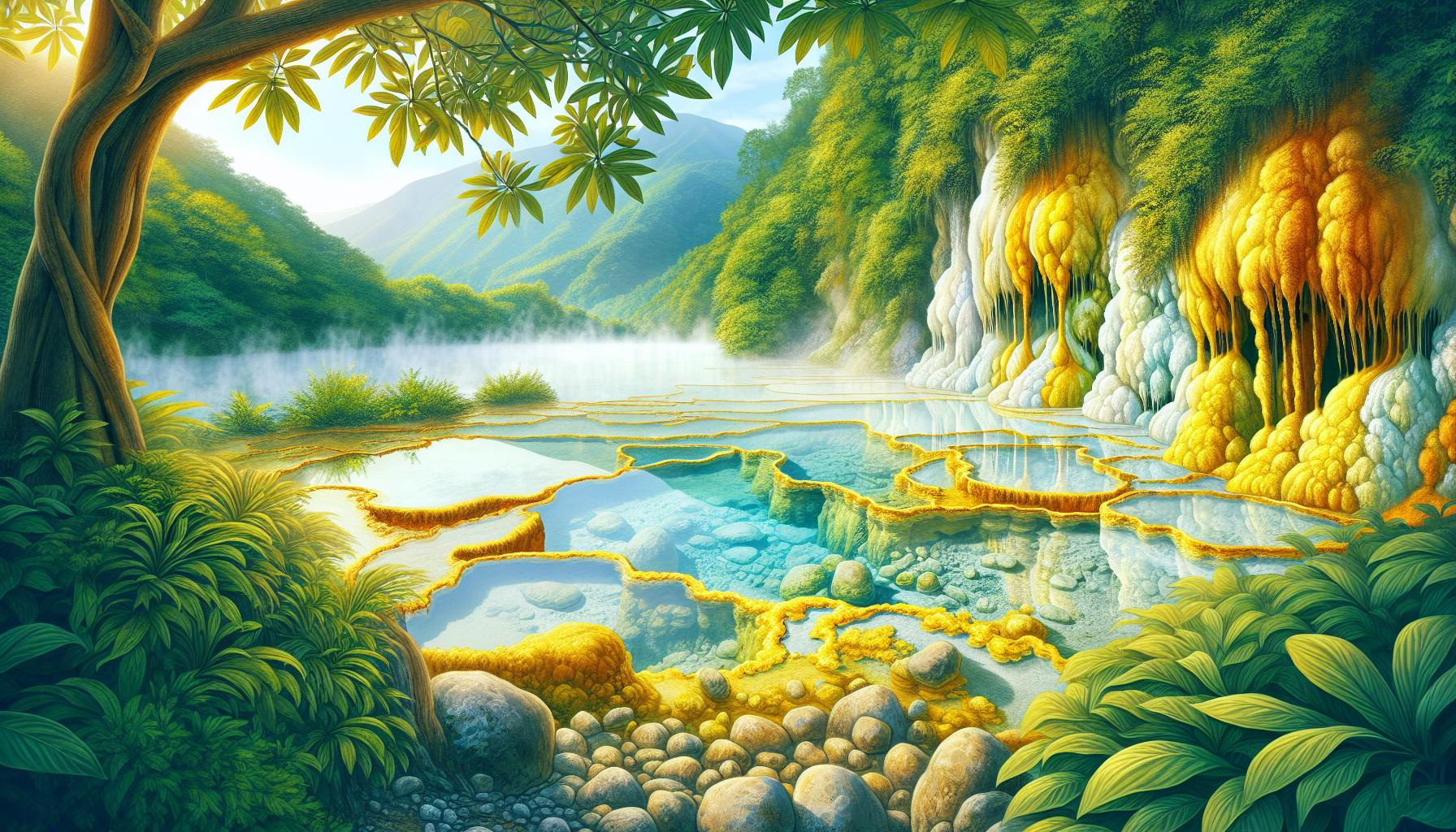Physical Address
304 North Cardinal St.
Dorchester Center, MA 02124
Physical Address
304 North Cardinal St.
Dorchester Center, MA 02124

Taiwan’s natural hot springs offer more than just a warm soak – they’re a gateway to ultimate relaxation and rejuvenation. From the mountainous regions of Yangmingshan to the coastal areas of Taitung, these geothermal wonders have drawn visitors for centuries with their therapeutic minerals and stunning landscapes.
What makes Taiwan’s hot springs truly special is their incredible diversity. Thanks to the island’s unique position along the Pacific Ring of Fire, visitors can choose from sulfur springs, sodium bicarbonate springs, and even rare seawater hot springs. Whether seeking a luxurious resort experience or an authentic local bathhouse, Taiwan’s hot spring culture combines Japanese-inspired hospitality with Chinese medicinal traditions.
Taiwan’s hot spring regions showcase distinct geological characteristics across different areas of the island. Each region offers unique mineral compositions therapeutic properties.
The Taipei metropolitan area features several renowned hot spring districts, with Beitou leading as the most accessible. Yangmingshan National Park contains multiple hot spring facilities nestled among volcanic landscapes. Wulai, located in New Taipei City, stands out for its sodium bicarbonate springs that produce crystal-clear water. The indigenous Atayal culture adds historical significance to Wulai’s hot spring experience. These northern springs maintain temperatures between 45-75°C (113-167°F) year-round.
Central Taiwan’s hot springs emerge from the region’s mountainous terrain. Guguan Hot Springs in Taichung sits along the Central Cross-Island Highway at 700 meters elevation. The area features carbonic acid springs known for their skin-beautifying properties. Lushan Hot Springs in Nantou County provides therapeutic sodium bicarbonate waters surrounded by cherry blossom trees. These springs maintain consistent temperatures of 48°C (118°F) throughout the seasons.
Southern Taiwan’s hot spring destinations concentrate in Kaohsiung Tainan areas. Guanziling in Tainan presents Taiwan’s only mud hot springs, rich in minerals beneficial for skin conditions. Baolai Hot Springs in Kaohsiung emerged after the 2009 Morakot typhoon, creating new spring sources. The springs contain high levels of sodium bicarbonate metasilicate maintaining temperatures around 55°C (131°F). Local agricultural products like coffee tea plantations surround these southern facilities.

Taiwan’s diverse geological formations create distinct varieties of hot springs with unique mineral compositions. These thermal waters range from clear to milky white based on their mineral content.
Sulfur springs contain high concentrations of hydrogen sulfide producing a distinctive rotten egg odor. These springs feature milky-white waters rich in minerals including sulfur sodium chloride iron. Located primarily in volcanic regions like Beitou Yang Ming Mountain area sulfur springs offer therapeutic benefits for skin conditions respiratory ailments arthritis. The water temperature averages 45-75°C creating optimal conditions for thermal therapy sessions. Visitors recognize these springs by their characteristic cloudy appearance yellow-tinged rocks surrounding the source.
Carbonate springs emerge from limestone-rich geological formations containing high levels of calcium magnesium carbonates. These crystal-clear waters appear colorless odorless with temperatures ranging between 35-55°C. Found predominantly in central Taiwan’s mountainous regions including Guguan Lushan areas carbonate springs provide relief for cardiovascular conditions digestive issues muscle tension. The mineral composition creates a silky-smooth sensation on the skin leaving bathers feeling refreshed energized.
Sodium bicarbonate springs feature alkaline-rich waters containing sodium potassium bicarbonate minerals. These springs maintain temperatures between 40-60°C producing clear transparent waters with a slightly sweet taste. Located in regions like Wulai Jiaoxi the springs’ alkaline properties help neutralize body acidity improve circulation boost metabolism. Regular soaking in these waters enhances skin elasticity reduces inflammation promotes cellular regeneration. The springs’ neutral pH makes them gentle enough for extended bathing sessions.
Taiwan’s hot spring accommodations range from opulent resorts to traditional bathhouses, offering diverse experiences across multiple price points. Each property combines natural thermal waters with distinct amenities based on location regional characteristics.
The Grand View Resort Beitou leads Taiwan’s premium hot spring experiences with private volcanic mineral pools in each suite starting at $450 per night. The Villa 32 provides an exclusive adults-only environment featuring Japanese-inspired design elements five private spa rooms. Fleur de Chine Hotel at Sun Moon Lake incorporates mountain views with rooftop infinity pools containing mineral-rich waters from Tatun Volcano. These properties include additional amenities:
Affordable hot spring hotels concentrate in Taipei’s Beitou district Yilan’s Jiaoxi area offering rooms from $80-150 per night. Spring City Resort provides clean comfortable accommodations with both indoor outdoor communal pools. Chyuan Du Spring Resort features traditional tatami rooms basic spa facilities at reasonable rates. Key features include:
Taiwan’s hot springs offer unique experiences throughout the year, with each season presenting distinct advantages for visitors. The optimal timing depends on personal preferences balanced against factors like crowd levels, weather conditions and pricing variations.
Peak hot spring season runs from October through March when temperatures drop to 15-22°C (59-72°F). Visitors flock to hot springs during Chinese New Year (January/February) creating a festive atmosphere with cultural celebrations. Weekend occupancy rates reach 90% at popular locations like Beitou and Wulai during these months. The contrast between cool air temperatures and warm thermal waters creates an optimal soaking experience. Many hot spring hotels include seasonal amenities like heated outdoor pools or covered walkways during peak months.
April through September brings reduced crowds and lower rates, with some accommodations offering 30-40% discounts. Morning visits between 6-9 AM provide peaceful soaking experiences even during summer months. The naturally cool mountain locations of springs like Guguan and Lushan maintain comfortable ambient temperatures. Off-peak visitors enjoy enhanced privacy at outdoor pools plus easier reservations at premium facilities. Several hot spring regions pair summer visits with nearby attractions like the Yangmingshan flower festival or Wulai’s river activities.
Taiwan’s hot spring culture combines Japanese bathing traditions with Chinese wellness practices. Visitors respect specific protocols to ensure a harmonious experience for everyone.
Hot spring etiquette in Taiwan requires thorough cleansing before entering the pools. Bathers shower with soap at designated stations then rinse completely before approaching the springs. Many facilities provide separate gender areas where clothing is prohibited. Quiet conversation maintains the peaceful atmosphere. Visitors tie long hair back to keep pools clean. Tattoos face restrictions in certain establishments, requiring coverage or limiting access to private baths. Photography remains prohibited in most bathing areas. Traditional wooden buckets serve as seats for washing stations. Communal areas feature multiple temperature pools arranged from coolest to hottest.
Hot springs deliver therapeutic benefits through mineral-rich waters that penetrate skin cells. Soaking increases circulation enhances metabolism reduces muscle tension. Medical conditions like heart problems high blood pressure pregnancy require physician consultation before bathing. Limiting soaking time to 15-20 minutes prevents overheating dehydration. Signs of discomfort include dizziness rapid heartbeat excessive sweating signal time to exit. Drinking water before during after sessions maintains hydration. Children under 12 need adult supervision near hot spring pools. Eating large meals 1 hour before bathing increases discomfort. Temperature variations between pools range from 35-45°C (95-113°F).
| Safety Guidelines | Recommended Duration |
|---|---|
| General Soaking | 15-20 minutes |
| High Temperature Pools (42-45°C) | 5-10 minutes |
| Moderate Temperature Pools (38-41°C) | 15-25 minutes |
| Cool Pools (35-37°C) | 30 minutes |
Taiwan’s hot springs stand as remarkable natural treasures offering diverse experiences for every type of traveler. From the volcanic springs of Beitou to the therapeutic waters of Guanziling these thermal wonders combine natural healing properties with exceptional hospitality.
Whether seeking luxury wellness retreats or authentic local bathhouses visitors will find the perfect spot to unwind throughout the year. The island’s unique blend of Japanese and Chinese bathing cultures creates an enriching experience that goes beyond mere relaxation.
Taiwan’s hot springs aren’t just places to soak – they’re gateways to understanding the island’s geological wonders cultural heritage and dedication to wellness. They represent some of Asia’s finest thermal experiences making Taiwan a must-visit destination for hot spring enthusiasts.